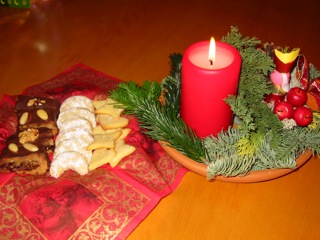AUSTRIA
Contributors: Gabriele Weichart, Hermann Mückler, Ruth Kutalek
Introduction: * (a personal note by Ruth Kutalek)
Having drawn on the cooking traditions of the former monarchy countries of the Austro-Hungarian empire, Austria is known today for its delicious sweets and cookies. Especially in the weeks and days before Christmas, Austrian homes are rich with the fragrance of baking. Sweet "breads", cakes, vanilla crescents and Christmas biscuits are prepared but were traditionally not allowed to be eaten until the evening of December 24th. As a child the most interesting evening was when the dough of the Vanillekipferln (vanilla crescents) was made. The raw dough in itself is delicious and without my mother noticing, or this is what I thought, small bits and pieces of unbaked dough went into my and my brothers' watering mouths. Our mother's argument that the raw dough would not be good for us and would even form an indigestible mass in our stomachs was easily disproved by years of my own experience. After all, nobody ever died of unbaked Vanillekipferln!
Photograph (c)2008 Gabriele Weichart
In Austria (and southern Germany) the Christkind (the Christ child) is often depicted as female and stands synonymously for Christmas. December 24th, Christmas Eve, the Holy Evening, has always been more important than Christmas Day in Austria. The Christmas tree, which was introduced to parts of Europe at the beginning of the 19th century, is decorated with glass balls, candles and sweets, and the presents are put under it. Christmas Eve is actually a day of fasting. At lunch often soup and a strudel (with nuts or poppy seeds) is served. Dinner often consists of baked carp or other fish in breadcrumbs with potato salad, or there may simply be cold dishes (cheese and sausages) with white bread. For Christmas Day a fat roast goose with red cabbage and dumplings is one of the traditional dishes.
* (c)Copyright 2008 Ruth Kutalek, Helen Macbeth. Permission is hereby granted to reproduce and distribute copies of this Introduction to recipes for Austria solely for the purposes of non-profit domestic use or non-profit educational purposes in either case provided that copies are distributed at or below cost and that the author's source and copyright notice are included on each copy.
